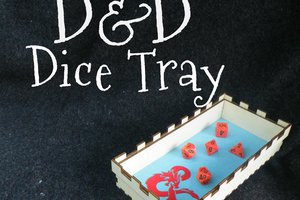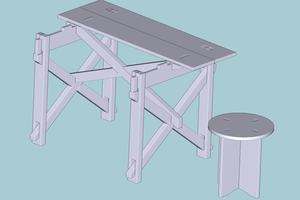


This is not my model. I came across this AT-ST Scout Walker by Billy McCoy on Thingiverse.
As you can see, it's pretty cool, but Billy's building instructions did not work so well - he'd improved the design, updated the files, but left the build instructions as they were. That made things a little confusing, so I decided to write some myself.
Step 1: Files & Glue


You can start by downloading the SVG or DXF file from Thingiverse, or you can use the ECP file I made for my own laser cutter (on this step). The only difference between Billy's files and my own is that I set the cutting order to drop out the scraps first, and added a small plaque to stand with the finished model.
It is scale to work with 3mm thick material - I used poplar plywood, MDF would also work well.
If you’re one of those folk who don’t have their own laser cutter, you can always use the Ponoko laser cutting service to get a set of parts for Billy’s Walker. Use the SVG file I’ve attached to this step and you can get a set of parts cut from a “P2” sheet of MDF for $43.
Since I used plywood, I used glue to fix the parts together.
Download Billy McCoy Walker 3mm P2.svg
Step 2: Start With the Body.



The body is a simple box, but you need to be careful about which way round you fix the parts - the etching on the side will guide how you fit the legs later.
You also need to make sure that the cross-shaped hole is at the right end, for fitting the neck & head.
Step 3: Roof and Neck




Set the body aside - as it dries, you can put together the cabin roof and the neck.
Be careful not to glue the disc with the cross-shaped hole into the roof, and it forms one end of the neck.
The neck parts slot & glue together, then the disc glues on the end furthest from the wide section.
Step 4: The Hips


Look for the six small oval-ish parts.
They glue together to make two spacers - pay attention to the slight bulge on one end when you are lining them up.
Step 5: Legs, Part One




Find the parts laid out in the first image.
Turn the bird-shaped parts over, then glue the longer part on top at the circular part - there are two etched lines to help you line them up.
Step 6: Legs, Part Two



Another find-the-parts-and-glue-them step.
Use the etched lines and small holes to line up and glue them.
Note that the longer parts have been turned over between the first and second photos.
Again, set them aside to dry.
Step 7: Legs, Part Three


The sections you constructed in the previous two steps now get glued together.
You should end up with the bird-shaped parts, and the shorter parts, sandwiched between two longer parts.
Step 8: Legs, Meet Hips



The bird-shaped section at the top of the legs has an engraved shape.
The non-bulged end of the hips glues to this shape. This is one of the joints that will bear the weight of the finished model, so you should clamp it while it dries.
Step 9: Feet



While the legs and hips are drying, you can build the feet.
The construction is obvious, but be aware that the arched pieces come in two slightly different sizes - the smaller ones come closer to the toes.
Step 10: Chin Gun



While the other parts are drying, it's an ideal time to build the armaments.
The chin gun is made of three parts that glue in quite an obvious manner.
Step 11: Right-cheek Weapon Pod




The gun that will end up on the right "cheek" of the walker is made of three layers glued together.
The etched lines show you how to line them up.
Step 12: Left-cheek Gun





The left-cheek gun is more complex, made of five parts.
The two etched gun-barrels get layered together (the short one gets turned over and glues underneath).
The other parts slide on on order - do a dry run before you glue to make sure that the gun-barrels finish flush with the squarish section.
Step 13: The Head






The head is a little awkward to glue, because none of the angles are at ninety degrees....
Read more » Mark Langford
Mark Langford



 mclien
mclien